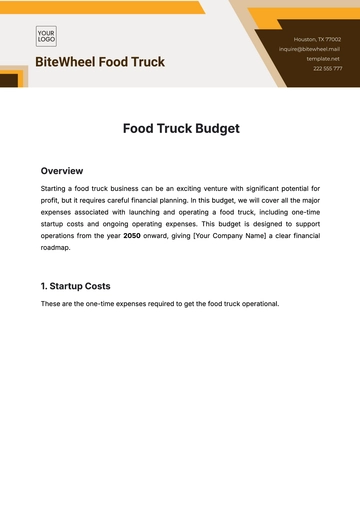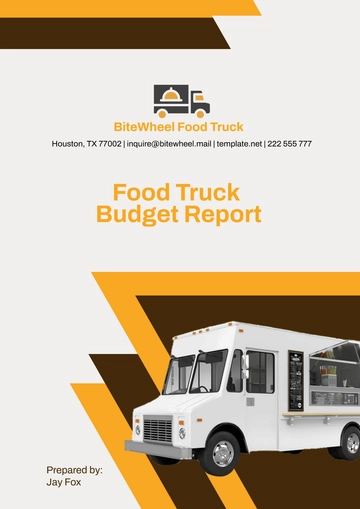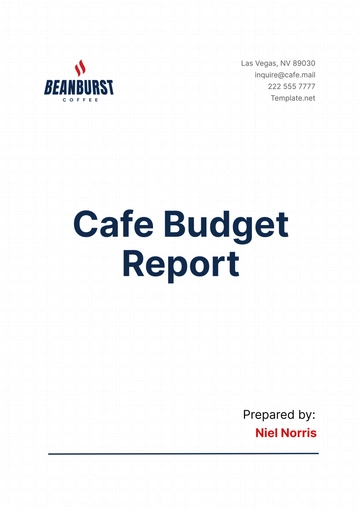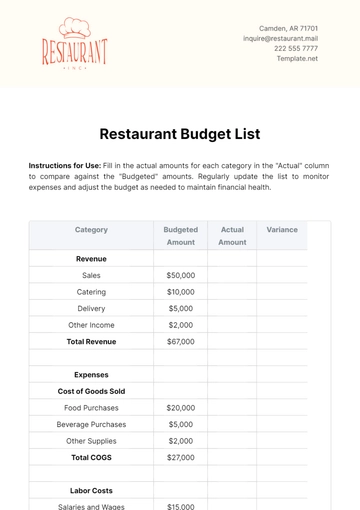Free Cafe Budget Report
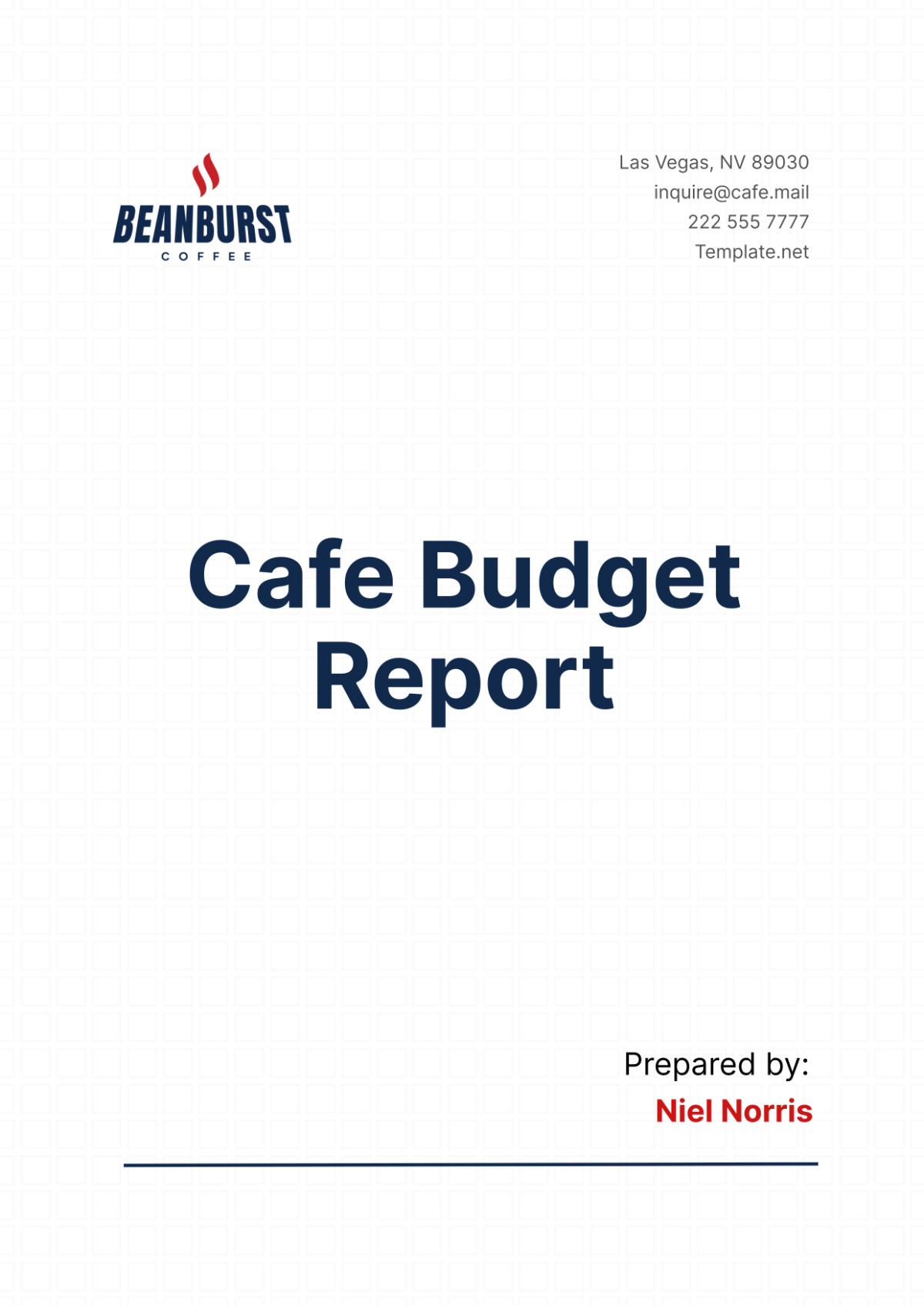
Date: January 5, 2050
I. Executive Summary
This report provides a comprehensive budget analysis for [Your Company Name] Cafe for the year 2050. The primary objective is to assess the financial health and needs of the cafe, focusing on revenue, expenditures, and net profit margins to ensure sustainability and growth. The analysis includes a detailed breakdown of all revenue streams, expenditures across various departments, and profit margins. Additionally, this report provides future financial projections and strategic recommendations for cost reduction and revenue enhancement.
II. Financial Overview
A. Revenue
Total Revenue for 2050: $500,000
This section includes a detailed breakdown of all revenue streams, highlighting the diverse sources of income for the cafe.
Revenue Source | Amount |
|---|---|
Dine-In Services | $300,000 |
Take-Out Services | $100,000 |
Online Orders | $50,000 |
Catering Services | $30,000 |
Merchandise Sales | $20,000 |
Total | $500,000 |
Analysis: The majority of our revenue comes from dine-in services, accounting for 60% of the total revenue. Take-out services and online orders contribute 20% and 10%, respectively, while catering services and merchandise sales make up the remaining 10%.
B. Expenditures
Total Expenses for 2050: $400,000
Detailed analysis of expenses includes rent, utilities, salaries, inventory purchases, and other operational costs.
Expenditure Category | Amount |
|---|---|
Rent | $60,000 |
Utilities | $30,000 |
Staff Salaries | $150,000 |
Food Supplies | $80,000 |
Equipment Maintenance | $20,000 |
Marketing | $20,000 |
Miscellaneous Expenses | $40,000 |
Total | $400,000 |
Analysis: Staff salaries represent the largest expenditure, followed by food supplies and rent. This breakdown emphasizes the importance of efficient staff management and inventory control.
C. Profit Margins
Net Profit for 2050: $100,000
Discussion on the net profit margins and comparison with previous years to gauge trends and performance.
Year | Revenue | Expenses | Net Profit |
|---|---|---|---|
2048 | $450,000 | $360,000 | $90,000 |
2049 | $475,000 | $380,000 | $95,000 |
2050 | $500,000 | $400,000 | $100,000 |
Analysis: The net profit margin for 2050 is 20%, showing a consistent improvement over the past three years. This indicates effective cost management and steady revenue growth.
III. Departmental Budgets
A. Kitchen Operations
Detailed budget allocation for kitchen operations, including food supplies, equipment maintenance, and staff salaries.
Category | Amount |
|---|---|
Food Supplies | $80,000 |
Equipment Maintenance | $20,000 |
Kitchen Staff Salaries | $90,000 |
Total | $190,000 |
Analysis: Kitchen operations account for 47.5% of the total budget, with a significant portion allocated to staff salaries and food supplies, highlighting the importance of maintaining high standards in food quality and kitchen efficiency.
B. Front-of-House
Budget breakdown for front-of-house activities such as customer service, decoration, and staff training programs.
Category | Amount |
|---|---|
Customer Service Staff | $60,000 |
Decoration and Ambiance | $10,000 |
Staff Training Programs | $10,000 |
Total | $80,000 |
Analysis: Front-of-house operations represent 20% of the total budget. Investing in customer service and staff training ensures a high-quality customer experience, which is crucial for retaining and attracting customers.
C. Marketing and Promotion
Allocation for marketing campaigns, social media management, and promotional events to increase cafe visibility and customer base.
Category | Amount |
|---|---|
Digital Marketing | $10,000 |
Social Media Management | $5,000 |
Promotional Events | $5,000 |
Total | $20,000 |
Analysis: Marketing and promotion constitute 5% of the total budget. A focused investment in digital marketing and social media can significantly enhance brand visibility and customer engagement.
IV. Future Projections
This chapter presents a detailed financial projection for [Your Company Name] Cafe over the next five years. The projections include expected revenue growth, anticipated costs, and strategic investments aimed at expansion and improvement. These projections are based on historical data, market trends, and strategic initiatives planned for the future.
Revenue Projections
The revenue projections for the next five years are detailed below. These figures reflect our expectations for growth based on market expansion, increased customer engagement, and new revenue streams.
Year | Revenue |
|---|---|
2051 | $550,000 |
2052 | $600,000 |
2053 | $650,000 |
2054 | $700,000 |
2055 | $750,000 |
Analysis:
2051: We anticipate a 10% increase in revenue, reaching $550,000. This growth is driven by enhanced marketing efforts and the introduction of new menu items.
2052: Revenue is projected to increase by approximately 9%, reaching $600,000. The growth factors include the expansion of our catering services and increased foot traffic from targeted promotional events.
2053: Expected revenue of $650,000, a growth of around 8%, supported by the full implementation of loyalty programs and customer retention strategies.
2054: Revenue is projected to grow to $700,000, reflecting a 7.7% increase, driven by seasonal promotions and community engagement initiatives.
2055: We expect revenue to reach $750,000, marking a 7.1% increase, with continued growth from new product offerings and enhanced customer experiences.
Expense Projections
The following table outlines the projected operating expenses for the next five years. These projections include costs associated with rent, utilities, staff salaries, marketing, and other operational expenses.
Year | Expenses |
|---|---|
2051 | $420,000 |
2052 | $440,000 |
2053 | $460,000 |
2054 | $480,000 |
2055 | $500,000 |
Analysis:
2051: Operating expenses are expected to be $420,000, reflecting initial investments in marketing and staff training.
2052: Expenses will increase to $440,000 due to higher costs in expanding catering services and enhanced marketing campaigns.
2053: Projected expenses are $460,000, with continued investment in staff development and technology upgrades to improve operational efficiency.
2054: Expenses are anticipated to rise to $480,000, including costs for maintaining high-quality customer service and additional marketing efforts.
2055: Operating expenses will reach $500,000, reflecting consistent investment in growth initiatives and operational improvements.
Profit Projections
Net profit projections for the next five years are summarized in the table below. These figures represent the expected profitability after accounting for all expenses.
Year | Net Profit |
|---|---|
2051 | $130,000 |
2052 | $160,000 |
2053 | $190,000 |
2054 | $220,000 |
2055 | $250,000 |
Analysis:
2051: Net profit is projected to be $130,000, reflecting a solid start to the planned growth trajectory.
2052: Profit is expected to increase to $160,000, driven by higher revenue from new services and controlled expenses.
2053: We anticipate net profit to grow to $190,000, supported by increased customer loyalty and operational efficiencies.
2054: Profit will reach $220,000, with benefits from community engagement and refined marketing strategies.
2055: Net profit is projected to be $250,000, marking significant growth due to expanded services and sustained customer engagement.
Strategic Investments
To support these financial projections, strategic investments will be made in the following areas:
Marketing and Promotion: Increasing the budget for digital marketing, social media engagement, and community events to attract and retain customers.
Staff Training and Development: Investing in comprehensive training programs to enhance service quality and efficiency.
Technology Upgrades: Implementing advanced POS systems, customer relationship management (CRM) tools, and other technologies to streamline operations and improve customer experiences.
Product Innovation: Developing new menu items and expanding the range of offerings to cater to evolving customer preferences.
The financial projections for [Your Company Name] Cafe indicate a positive growth trajectory over the next five years. By strategically investing in marketing, staff development, technology, and product innovation, we aim to enhance our revenue, manage expenses effectively, and significantly increase net profit. These projections provide a solid foundation for future planning and demonstrate the potential for sustainable growth and profitability.
V. Recommendations
This section outlines strategic recommendations aimed at enhancing the financial health and operational efficiency of [Your Company Name] Cafe. The focus is on implementing cost reduction strategies to lower operational expenses and exploring revenue enhancement methods to boost overall profitability. These recommendations are designed to sustain the cafe’s growth, maintain high service quality, and increase customer satisfaction.
A. Cost Reduction Strategies
Identifying areas for cost reduction without compromising service quality is crucial for maintaining profitability. The following strategies focus on optimizing resources and reducing unnecessary expenses.
1. Bulk Purchasing
Strategy: Negotiate bulk purchase agreements with suppliers to reduce food supply costs.
Implementation:
Supplier Negotiations: Develop long-term relationships with suppliers to secure bulk purchase discounts. By committing to larger orders, we can negotiate better prices and terms.
Forecasting Demand: Utilize sales data to accurately forecast demand and avoid over-purchasing. This ensures that bulk buying does not lead to excess inventory or waste.
Consortium Buying: Consider joining a purchasing consortium with other local cafes or restaurants to increase buying power and access bulk discounts.
Benefits:
Cost Savings: Significant reductions in food supply costs, improving overall profit margins.
Consistency: Secure a consistent supply of ingredients, reducing the risk of shortages or price fluctuations.
2. Energy-Efficient Appliances
Strategy: Invest in energy-efficient appliances to reduce utility costs.
Implementation:
Audit Current Equipment: Conduct an energy audit to identify inefficient appliances and systems.
Upgrade Equipment: Replace outdated equipment with energy-efficient models, such as LED lighting, high-efficiency ovens, and refrigeration units.
Employee Training: Train staff on best practices for energy conservation, such as turning off equipment when not in use and optimizing usage times.
Benefits:
Reduced Utility Bills: Lower energy consumption translates to reduced utility bills, leading to substantial cost savings over time.
Sustainability: Contributes to the cafe's sustainability initiatives, enhancing our brand image among eco-conscious customers.
3. Inventory Management
Strategy: Implement better inventory management practices to minimize waste.
Implementation:
Inventory Tracking Software: Utilize inventory management software to track stock levels in real-time, forecast demand, and automate reordering processes.
FIFO System: Adopt the First In, First Out (FIFO) inventory system to ensure older stock is used before new stock, reducing spoilage.
Regular Audits: Conduct regular inventory audits to identify and address discrepancies promptly.
Benefits:
Minimized Waste: Reducing food waste directly impacts the bottom line by lowering the cost of goods sold.
Improved Cash Flow: Efficient inventory management frees up cash that would otherwise be tied up in excess stock.
B. Revenue Enhancement
Exploring new revenue streams and optimizing existing ones are essential for sustaining growth and increasing profitability. The following recommendations aim to enhance revenue through innovative approaches.
1. Menu Updates
Strategy: Introduce new and seasonal menu items to attract repeat customers and new patrons.
Implementation:
Customer Feedback: Gather customer feedback to understand preferences and trends. Use surveys, social media polls, and direct feedback to guide menu development.
Seasonal Menus: Develop seasonal menu items that leverage fresh, in-season ingredients. Highlight these items in marketing campaigns to attract interest.
Specialty Items: Introduce specialty items, such as limited-edition drinks or exclusive food offerings, to create excitement and encourage frequent visits.
Benefits:
Customer Retention: Keeping the menu fresh and interesting helps retain existing customers and attract new ones.
Increased Sales: Unique and seasonal items can command higher prices, boosting average transaction values.
2. Catering Services
Strategy: Expand into catering services for local businesses and events to create an additional revenue stream.
Implementation:
Market Research: Conduct market research to identify potential catering clients, such as local businesses, event planners, and community organizations.
Service Packages: Develop a range of catering packages tailored to different needs, including corporate events, private parties, and community functions.
Marketing Campaigns: Promote catering services through targeted marketing campaigns, including social media, email newsletters, and partnerships with local event venues.
Benefits:
Diversified Revenue: Catering services provide a steady revenue stream that is not dependent on daily foot traffic.
Brand Exposure: Catering high-profile events can enhance brand visibility and attract new customers to the cafe.
3. Special Events
Strategy: Host themed events, workshops, and live music nights to draw in more customers and create a lively atmosphere.
Implementation:
Event Planning: Develop a calendar of events, including themed nights (e.g., trivia, karaoke), workshops (e.g., coffee brewing, cooking classes), and live music performances.
Partnerships: Collaborate with local artists, musicians, and experts to host these events, providing them with a platform while attracting their followers to the cafe.
Promotion: Use social media, in-cafe signage, and local advertising to promote upcoming events and generate buzz.
Benefits:
Increased Foot Traffic: Special events create reasons for customers to visit more frequently and stay longer, boosting sales.
Community Engagement: Hosting events fosters a sense of community, positioning the cafe as a vibrant local hub.
Implementing these cost reduction strategies and revenue enhancement methods will help [Your Company Name] Cafe optimize operational efficiency and boost profitability. By focusing on bulk purchasing, energy efficiency, and inventory management, we can reduce expenses without compromising service quality. Simultaneously, updating the menu, expanding catering services, and hosting special events will attract more customers and increase revenue. These recommendations provide a roadmap for sustainable growth and long-term financial health.
VI. Conclusion
Summary
The budget analysis for 2050 indicates that [Your Company Name] Cafe is in a healthy financial position with a net profit margin of 20%. Revenue streams are well-diversified, and expenditures are efficiently managed. Future projections show promising growth in revenue and profit over the next five years.
Strategic Recommendations
To maintain and enhance our financial health, we recommend implementing cost reduction strategies, exploring new revenue streams, and continuing to invest in marketing and customer service. These efforts will ensure sustained growth and profitability.
VII. Contact Information
For further inquiries or detailed discussion, please contact:
[Your Company Name]
Email: [Your Company Email]
Phone: [Your Company Number]
Address: [Your Company Address]
Website: [Your Company Website]
Follow us on social media: [Your Company Social Media]
Prepared by:
[Your Name]
[Your Position]
[Your Company Name]
[Your Company Address]
[Your Company Number]
[Your Company Email]
[Your Company Website]
- 100% Customizable, free editor
- Access 1 Million+ Templates, photo’s & graphics
- Download or share as a template
- Click and replace photos, graphics, text, backgrounds
- Resize, crop, AI write & more
- Access advanced editor
Optimize your cafe's financial management with Template.net's Cafe Budget Report Template. Effortlessly track and analyze your cafe's expenses, revenues, and cash flow with this comprehensive template. Utilizing our AI editor tool, customize and tailor the budget report to suit your cafe's unique needs and goals. Stay on top of your finances and make informed decisions to drive profitability and success. Get started today with Template.net.
You may also like
- Budget Sheet
- Personal Budget
- Non Profit Budget
- Monthly Budget
- Project Budget
- HR Budget
- Company Budget
- Home Budget
- Weekly Budget
- College Budget
- Business Budget
- Construction Budget
- Small Business Budget
- Hotel Budget
- Annual Budget
- Home Renovation Budget
- Household Budget
- Student Budget
- Grocery Budget
- Marketing Budget
- Corporate Budget
- Startup Budget
- Manufacturing Budget
- Church Budget
- University Budget
- Annual Budget Plan
- Event Budget
- Operating Budget
- Travel Budget
- Food Budget
- IT and Software Budget
- School Budget
- Real Estate Budget
- Sales Budget
- Conference Budget
- Budget Finance
- Freelancer Budget
- Budget Advertising

